About six or more soil types are found distributed across different ecological zones. The soils are:
1. Alluvia’s
Three types of alluvials are important, namely alluvial of marine deposits found in mangrove areas which are suitable only for coconut growing; the alluvial near the coast which has a high sulphide content and when drained has the tendency to become acidic, and alluvial on lacustrine and riverine deposit, which constitutes the most useful alluvial soil under controlled drainage conditions.
2. Ferrasols
These are also called acid sands (pH= 5.0-5.5) and are also reddish-yellow. They cover the southern parts of the forest zone of western Nigeria and extensive areas of mid-Western and eastern states. They are of low fertility or agricultural value but potentially suitable for mechanical agriculture.
3. Ferruginous Tropical Soil
This is soil formed from crystalline acid rock, except those developed on sandy, undifferentiated, and sometimes hydromorphic soils. It is of high natural fertility but traditional management practices have caused problems with crop utilization.
In the forest zone, it is suitable for planting cocoa while in the savanna zone it is suitable for export and food crops e.g. beniseed, cotton, guinea-corn, maize, yam, millet, and groundnut. The soil is relatively more suitable for agriculture than any other soil type.
4. Lithosols

These soils are of local significance and are usually associated with ferruginous tropical soils. Agricultural activity is very low but they need to be protected from soil erosion to avoid damaging adjacent and more fertile soil.
5. Vertisols
These soils have characteristics of considerable agricultural importance. These features include dark color with a large amount of clays of the expanding lattice type (kaolinite); occurrence of deep cracks during the dry season; very limited horizon/less deep development; richness in calcium, especially CaSO3 and CaSO4.
Those developed from calcerous rocks have the greatest potential for agriculture. However, they have little use because of the difficulty of tillage but dry season guinea corn is extensively grown in some.
6. Regosols
These overlay semi-arid brown and reddish-brown soil. Organic matter content is nearly constant to a considerable depth. Many of these soils show an increase in clay content with soil depth.
Generally, organic matter and nutrient contents of soils decline during production or cropping and increase under fallow for varying periods. Therefore, several methods are used by the farmers to maintain soil fertility, including crop rotations, shorter fallows, and the use of crop residues.
Read Also: The Biological Factors of Soil Affecting Crop Production
Read Also: How Family Farming Can Yield Global Food Sufficiency

